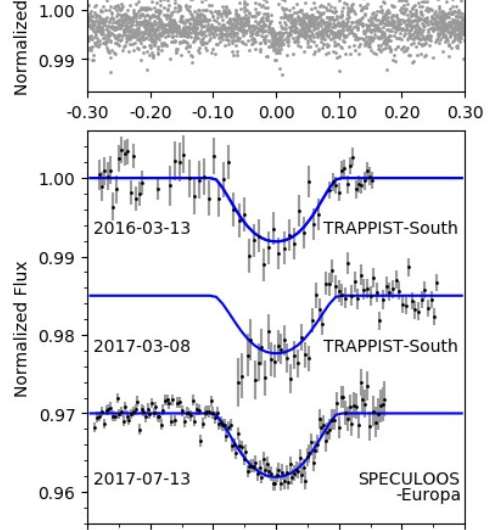February 12, 2018 report
Astronomers discover a near-grazing transiting 'hot Jupiter'

An international group of astronomers has detected a new "hot Jupiter" exoplanet making a near-grazing transit of its host star. The newly found alien world, designated WASP-174b, is most likely similar in size and mass to Jupiter, however much hotter than our solar system's biggest planet. The discovery is reported February 2 in a paper published on arXiv.org.
A grazing transit means that a planet only partially transits its parent star's disc. Such planets are important for researchers, as they offer a great opportunity to find additional bodies orbiting host stars. This is because other, yet undetected objects would perturb the grazing planet's orbit and could potentially induce periodic variations of the transit impact parameter, leading to transit duration variations. However, although astronomers have identified hundreds of exoplanets, only a handful of grazing extrasolar worlds have been discovered to date.
Recently, a team of researchers led by Lorna Temple of the Keele University, U.K., has found a new example of a grazing exoplanet as part of the WASP-South transit survey. The astronomers identified a transit signal in the light curve of the star WASP-174 from the spectroscopic data gathered by the WASP-South telescope at the South African Astronomical Observatory (SAAO) in South Africa between May 2006 and June 2012. The planetary nature of this signal was later confirmed by Doppler tomography method using the HARPS spectrograph mounted on ESO's 3.6-m telescope, along with photometric data from the TRAPPIST South telescope and the SPECULOOS Southern Observatory, all located in Chile.
"We report here the discovery of a hot Jupiter found as a candidate in the WASP-South transit survey and confirmed by Doppler tomography using the ESO 3.6-m/HARPS spectrograph, together with follow-up photometry from the TRAPPISTSouth and SPECULOOS Southern Observatory telescopes," the researchers wrote in the paper.
The authors noted that due to the grazing or near-grazing transit of WASP-174b, the planet's radius was difficult to measure. They assume that the value of this parameter lies between 0.7 to 1.7 Jupiter radii.
Furthermore, the researchers added that the mass of WASP-174b is also uncertain, given that the parent star is hot (6,400 K) and rotates rapidly (rotation period below 4.4 days), which limits the accuracy and precision of radial-velocity measurements. They only managed to calculate that the planet's mass should be no greater than 1.3 Jupiter masses.
The study found that WASP-174b orbits its star every 4.23 days at a distance of about 0.0555 AU from the host. It is estimated that the planet's equilibrium temperature is 1,470 K.
According to the study, the derived parameters of WASP-174b suggest that the exoplanet is a fairly inflated as it should have a radius larger than expected in gas giant planets. It was also classified as a "hot Jupiter," given that it is similar in characteristics to Jupiter, orbits its parent star very closely, and therefore has a high surface temperature.
The host is a 1.65-billion-year old star of spectral type F6V, about 30 percent larger and more massive than the sun. It has a V-band magnitude of 11.9, which, according to the authors of the paper, makes WASP-174 the faintest "hot-Jupiter" system for which the shadow of the planet has been detected by tomographic methods.
More information: Discovery of WASP-174b: Doppler tomography of a near-grazing transit, arXiv:1802.00766 [astro-ph.EP] arxiv.org/abs/1802.00766
Abstract
We report the discovery and tomographic detection of WASP-174b, a planet with a near-grazing transit on a 4.23-d orbit around a V = 11.9, F6V star with [Fe/H] = 0.09 ± 0.09. The planet is in a moderately misaligned orbit with a sky-projected spin-orbit angle of λ = 31∘ ± 1∘. This is in agreement with the known tendency for orbits around hotter stars to be misaligned. Owing to the grazing transit the planet's radius is uncertain, with a possible range of 0.7-1.7 RJup. The planet's mass has an upper limit of 1.3 MJup. WASP-174 is the faintest hot-Jupiter system so far confirmed by tomographic means.
© 2018 Phys.org




















